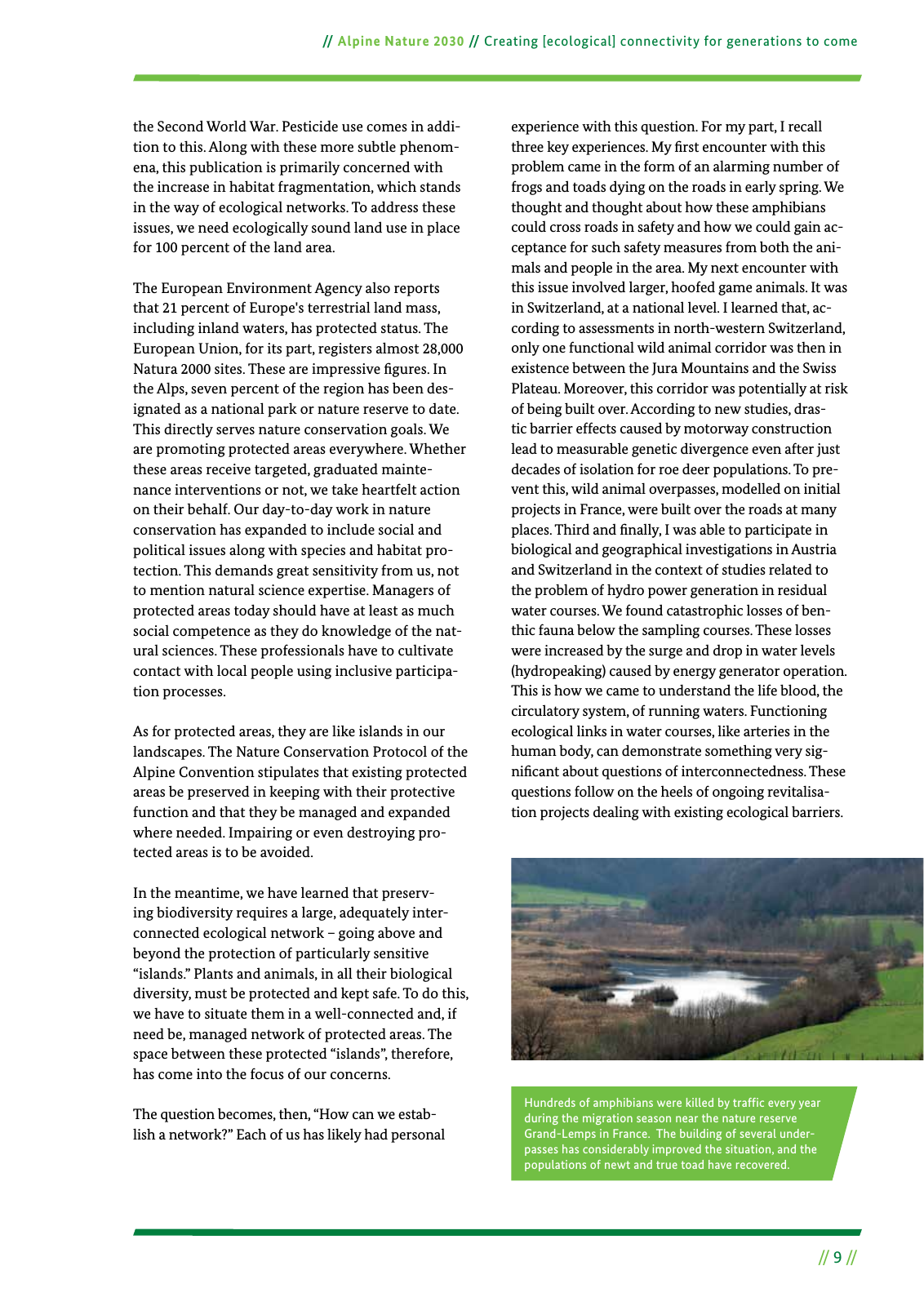the Second World War Pesticide use comes in addi tion to this Along with these more subtle phenom ena this publication is primarily concerned with the increase in habitat fragmentation which stands in the way of ecological networks To address these issues we need ecologically sound land use in place for 100 percent of the land area The European Environment Agency also reports that 21 percent of Europe s terrestrial land mass including inland waters has protected status The European Union for its part registers almost 28 000 Natura 2000 sites These are impressive gures In the Alps seven percent of the region has been des ignated as a national park or nature reserve to date This directly serves nature conservation goals We are promoting protected areas everywhere Whether these areas receive targeted graduated mainte nance interventions or not we take heartfelt action on their behalf Our day to day work in nature conservation has expanded to include social and political issues along with species and habitat pro tection This demands great sensitivity from us not to mention natural science expertise Managers of protected areas today should have at least as much social competence as they do knowledge of the nat ural sciences These professionals have to cultivate contact with local people using inclusive participa tion processes As for protected areas they are like islands in our landscapes The Nature Conservation Protocol of the Alpine Convention stipulates that existing protected areas be preserved in keeping with their protective function and that they be managed and expanded where needed Impairing or even destroying pro tected areas is to be avoided In the meantime we have learned that preserv ing biodiversity requires a large adequately inter connected ecological network going above and beyond the protection of particularly sensitive islands Plants and animals in all their biological diversity must be protected and kept safe To do this we have to situate them in a well connected and if need be managed network of protected areas The space between these protected islands therefore has come into the focus of our concerns The question becomes then How can we estab lish a network Each of us has likely had personal experience with this question For my part I recall three key experiences My rst encounter with this problem came in the form of an alarming number of frogs and toads dying on the roads in early spring We thought and thought about how these amphibians could cross roads in safety and how we could gain ac ceptance for such safety measures from both the ani mals and people in the area My next encounter with this issue involved larger hoofed game animals It was in Switzerland at a national level I learned that ac cording to assessments in north western Switzerland only one functional wild animal corridor was then in existence between the Jura Mountains and the Swiss Plateau Moreover this corridor was potentially at risk of being built over According to new studies dras tic barrier effects caused by motorway construction lead to measurable genetic divergence even after just decades of isolation for roe deer populations To pre vent this wild animal overpasses modelled on initial projects in France were built over the roads at many places Third and nally I was able to participate in biological and geographical investigations in Austria and Switzerland in the context of studies related to the problem of hydro power generation in residual water courses We found catastrophic losses of ben thic fauna below the sampling courses These losses were increased by the surge and drop in water levels hydropeaking caused by energy generator operation This is how we came to understand the life blood the circulatory system of running waters Functioning ecological links in water courses like arteries in the human body can demonstrate something very sig ni cant about questions of interconnectedness These questions follow on the heels of ongoing revitalisa tion projects dealing with existing ecological barriers Hundreds of amphibians were killed by traffic every year during the migration season near the nature reserve Grand Lemps in France The building of several under passes has considerably improved the situation and the populations of newt and true toad have recovered 9 Alpine Nature 2030 Creating ecological connectivity for generations to come

Hinweis: Dies ist eine maschinenlesbare No-Flash Ansicht.
Klicken Sie hier um zur Online-Version zu gelangen.
Klicken Sie hier um zur Online-Version zu gelangen.